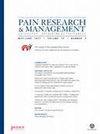Knee Osteoarthritis: Kinesiophobia and Isometric Strength of Quadriceps in Women
IF 2.5
3区 医学
Q2 CLINICAL NEUROLOGY
引用次数: 1
Abstract
Introduction Osteoarthritis is a disease characterized by progressive wear and tear of the joint, with the knee being the most affected region. These patients have reduced mobility and mobility, among other symptoms. Thus, it is necessary to know the variables that influence the ability to walk. Objective To analyze how much the gait capacity, in the performance of the six-minute walk test, can be influenced by the maximum isometric strength of the quadriceps or by kinesiophobia in women with knee osteoarthritis. Materials and Methods This is a cross-sectional study with a sample of 49 women diagnosed with osteoarthritis. The evaluation was carried out in a single moment. Variables studied isometric quadriceps strength, level of fear of movement (kinesiophobia), and ability to walk. Simple linear regression analyzes were performed, with gait ability as the dependent variable and maximum isometric strength and kinesiophobia as independent. Data were presented with mean and standard deviation and were analyzed by the SPSS Statistic 22.0 software, considering p < 0.05 as significant. Results The maximum isometric strength presents a significant difference, directly interfering with the gait ability; as kinesiophobia does not show a statistically significant difference, it does not directly interfere with the ability to walk. Conclusion Maximal quadriceps isometric strength directly interferes with gait ability in women with knee osteoarthritis, thus suggesting the inclusion of this strategy in treatment programs for this population.膝骨关节炎:女性股四头肌的运动恐惧症和等长力量
骨关节炎是一种以关节进行性磨损和撕裂为特征的疾病,膝关节是受影响最严重的区域。除其他症状外,这些患者的行动能力和活动能力降低。因此,有必要了解影响行走能力的变量。目的分析膝关节骨性关节炎患者进行6分钟步行试验时,股四头肌最大等长肌力或运动恐惧对步态能力的影响。材料和方法这是一项横断面研究,样本为49名诊断为骨关节炎的女性。评估是在一瞬间完成的。变量研究了等长股四头肌力量、运动恐惧水平(运动恐惧症)和行走能力。以步态能力为因变量,最大等长强度和运动恐惧症为独立变量,进行简单线性回归分析。数据以均数和标准差表示,采用SPSS统计22.0软件进行分析,以p < 0.05为差异有统计学意义。结果最大等长强度存在显著性差异,直接干扰步态能力;由于运动恐惧症在统计上没有显著的差异,它不会直接影响行走能力。结论:最大股四头肌等长力量直接干扰膝关节骨性关节炎妇女的步态能力,因此建议将该策略纳入该人群的治疗方案中。
本文章由计算机程序翻译,如有差异,请以英文原文为准。
求助全文
约1分钟内获得全文
求助全文
来源期刊

Pain Research & Management
CLINICAL NEUROLOGY-
CiteScore
5.30
自引率
0.00%
发文量
109
审稿时长
>12 weeks
期刊介绍:
Pain Research and Management is a peer-reviewed, Open Access journal that publishes original research articles, review articles, and clinical studies in all areas of pain management.
The most recent Impact Factor for Pain Research and Management is 1.685 according to the 2015 Journal Citation Reports released by Thomson Reuters in 2016.
 求助内容:
求助内容: 应助结果提醒方式:
应助结果提醒方式:


